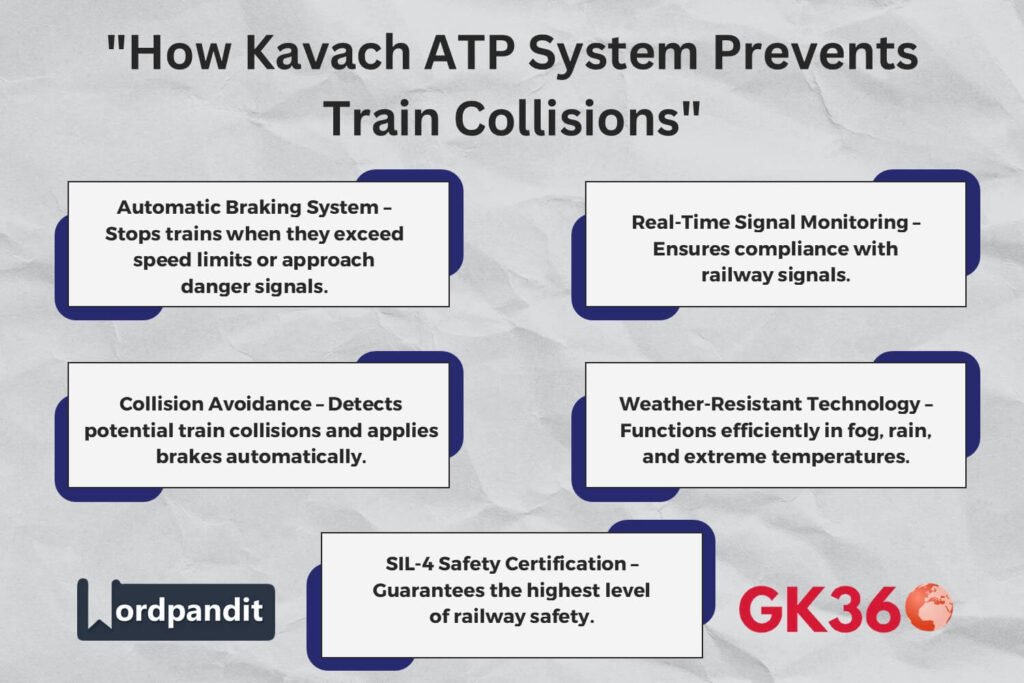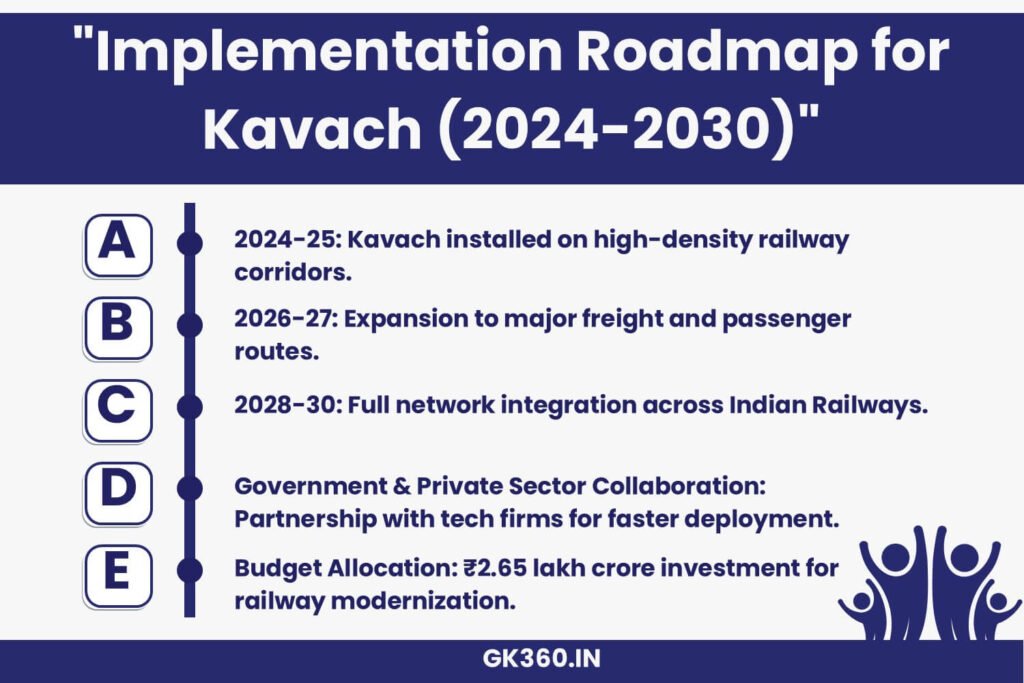Kavach ATP System: Revolutionizing Railway Safety in India
Introduction: India’s Next-Gen Railway Safety Revolution
India is set to undergo a transformational shift in railway safety with the nationwide deployment of Kavach – an Automatic Train Protection (ATP) system designed to prevent train collisions and enhance operational efficiency.
The Indian Railways—one of the largest railway networks in the world—is prioritizing safety, speed, and technology integration to reduce accidents. As confirmed by Union Minister Ashwini Vaishnaw, Kavach will be fully implemented across the country within six years, marking a milestone in train collision prevention technology.
With its Safety Integrity Level 4 (SIL-4) certification and government-backed funding, Kavach ATP is expected to reshape Indian railway safety standards, minimizing human error and improving passenger confidence.

Table of Contents
- What is the Kavach ATP System?
- How Does Kavach Work?
- Kavach Implementation in India: Timeline & Strategy
- Budget & Government Funding (2025-26)
- Key Features & Upgrades (Kavach 4.0)
- Impact on Railway Safety & Operations
- Challenges in Deployment
- Future of Railway Safety in India
- FAQs: Kavach & Railway Modernization
- Conclusion: A Safer Future with Kavach
What is the Kavach ATP System?
Kavach, meaning “shield” in Hindi, is a homegrown Automatic Train Protection (ATP) system developed to prevent train collisions, derailments, and signal violations.
🚄 Key Features of Kavach:
- Automatic Braking System: Stops trains if overspeeding or nearing a danger signal.
- Real-Time Signal Monitoring: Ensures trains follow speed restrictions.
- Weather Resilience: Operates efficiently in fog, rain, and extreme temperatures.
- Interoperability with Indian Railways: Compatible with all train types.
- Safety Integrity Level 4 (SIL-4) Certified: The highest safety rating, ensuring reliability.
Kavach is being hailed as India’s answer to global railway safety solutions like the European Train Control System (ETCS) and will play a pivotal role in accident prevention.
How Does Kavach Work?
Kavach is designed to minimize human error by automating critical safety decisions.
🚦 Key Working Mechanism:
- Signal Override Protection: If a train approaches a red signal (danger), Kavach automatically applies brakes.
- Speed Control: Kavach monitors train speed in real-time and reduces speed if limits are exceeded.
- Collision Prevention: If two trains are detected on the same track, Kavach prevents them from getting too close.
- Driver Assistance: Provides real-time alerts and data to locomotive pilots for improved decision-making.
This technology is expected to reduce train accidents by up to 95%, making it a game-changer in Indian Railways’ modernization efforts.
Kavach Implementation in India: Timeline & Strategy
To ensure a smooth nationwide rollout, the Indian government has formulated a phased implementation plan.
📅 Deployment Roadmap (2024-2030)
- 2024-25: Initial expansion across high-density railway corridors.
- 2026-27: Coverage extended to major freight & passenger routes.
- 2028-30: Full network integration, making India one of the world’s safest railway systems.
🔄 Role of Public-Private Partnerships (PPP)
The government is collaborating with private players to enhance efficiency and cost-effectiveness. Companies like Medha Servo Drives, HBL Power Systems, and Kernex Microsystems are leading the manufacturing and deployment process.
Budget & Government Funding (2025-26)
The Indian government has committed ₹2.65 lakh crore in capital expenditure for the railway sector in the 2025-26 fiscal year, a significant portion of which will go toward:
- 🔹 Kavach implementation and railway safety enhancements.
- 🔹 Infrastructure upgrades for seamless ATP system integration.
- 🔹 Research and development of smart railway technologies.
This investment underscores the government’s dedication to modernizing the Indian railway network and elevating safety standards to global levels.
Key Features & Upgrades (Kavach 4.0)
The latest version, Kavach 4.0, approved in July 2024, comes with enhanced features to tackle India’s unique railway challenges.
🚀 Key Upgrades in Kavach 4.0:
- ✔ Enhanced GPS Accuracy: Improved train positioning for better navigation.
- ✔ Advanced Signal Processing: Ensures clearer communication between control centers and locomotives.
- ✔ Weather-Resistant Technology: Functions seamlessly in fog, heavy rainfall, and extreme heat.
- ✔ AI-Driven Predictive Analytics: Detects potential risks and alerts railway operators proactively.
With these improvements, Kavach will significantly reduce railway accidents, optimize train schedules, and improve overall efficiency.
Impact on Railway Safety & Operations
The introduction of Kavach ATP technology will bring far-reaching benefits to Indian Railways.
💡 How Kavach Will Transform Indian Railways:
- ✅ Collision Prevention: Automatic braking eliminates the risk of human error.
- ✅ Optimized Train Schedules: Reduces delays by ensuring better speed regulation.
- ✅ Enhanced Passenger Confidence: Higher safety standards will increase ridership.
- ✅ Lower Maintenance Costs: Fewer accidents mean reduced infrastructure damage.
In the long run, Kavach will not only make train travel safer but also improve operational efficiency, boosting India’s railway modernization goals.
Challenges in Deployment
Despite its high potential, implementing Kavach across India’s vast railway network comes with certain challenges.
⚠ Key Challenges:
- 🔴 Integration with Existing Infrastructure: Many Indian railways still rely on outdated systems. Upgrading them for Kavach compatibility requires substantial investment.
- 🔴 High Initial Costs: The deployment cost is ₹50 lakh per kilometer, which makes full-scale implementation expensive.
- 🔴 Training of Railway Staff: Drivers and operators need extensive training to adapt to the new system.
- 🔴 Public-Private Coordination: Balancing the role of private sector innovation with government control over railway infrastructure can be complex.
To overcome these hurdles, continuous investment, phased deployment, and strategic partnerships with technology firms will be essential.
Future of Railway Safety in India
The success of Kavach is expected to pave the way for next-gen railway technologies, including:
- 🚄 Artificial Intelligence in Train Operations: AI-powered automation for real-time train tracking.
- 📡 IoT-Based Rail Monitoring: Smart sensors for predictive maintenance.
- 🔄 Integration with Global Railway Safety Systems: Aligning with European Train Control System (ETCS) standards.
By 2030, India’s railway network could become one of the safest and most technologically advanced in the world, setting a benchmark for developing nations.

FAQs: Kavach & Railway Modernization
❓ 1. What is Kavach in Indian Railways?
🔹 Kavach is an Automatic Train Protection (ATP) system designed to prevent train collisions and ensure railway safety through automated braking and speed control mechanisms.
❓ 2. How does Kavach prevent train collisions?
🔹 Kavach uses real-time GPS tracking, signal override mechanisms, and AI-based predictive analytics to apply automatic brakes if two trains are on the same track.
❓ 3. How much has the Indian government allocated for Kavach implementation?
🔹 The 2025-26 railway budget has set aside a significant portion of ₹2.65 lakh crore for Kavach deployment, infrastructure modernization, and safety enhancements.
❓ 4. Which trains will get Kavach first?
🔹 High-density railway corridors such as Delhi-Mumbai and Delhi-Kolkata will be among the first to receive Kavach, followed by other high-traffic routes.
❓ 5. How does Kavach compare to global railway safety systems?
🔹 Kavach is India’s equivalent to ETCS (European Train Control System) but is more cost-effective and designed for India’s diverse climatic and operational challenges.
Key Takeaways Table
| Aspect | Details |
|---|---|
| Purpose of Kavach | Prevent train collisions, enhance railway safety, and automate braking. |
| Key Features | Automatic braking, speed control, real-time signal monitoring, SIL-4 safety certification. |
| Implementation Plan | 2024-2030, starting with high-density corridors and expanding nationwide. |
| Budget Allocation | ₹2.65 lakh crore for railway safety and modernization (2025-26). |
| Technological Upgrades | AI-based predictive analytics, advanced GPS accuracy, and weather-resistant operations. |
| Challenges | High implementation cost, integration with old railway systems, and staff training requirements. |
| Future Prospects | AI-driven automation, IoT-based rail monitoring, and global railway safety standard integration. |
Related Terms:
- Kavach ATP System
- Indian Railways Safety
- Train Collision Prevention
- Automatic Braking System
- Railway Modernization
- Indian Railways 2025
- AI in Railway Safety
- Railway Safety Tech
- Kavach Implementation
- SIL-4 Certification
Conclusion: A Safer Future with Kavach
The deployment of Kavach ATP technology is a major milestone in Indian railway modernization. With government backing, private-sector collaboration, and technological advancements, India is on track to becoming a global leader in railway safety.
🚆 Why Kavach is a Game-Changer:
- ✅ Eliminates Train Collisions: Automatic braking prevents accidents.
- ✅ Boosts Passenger Confidence: Safer train journeys mean higher ridership.
- ✅ Supports Smart Railway Vision: Aligns with AI and IoT-based railway automation.
- ✅ Positions India as a Leader: Sets new global benchmarks in railway safety and technology.
As Kavach continues to expand nationwide, India’s railway system will transform into one of the safest, most efficient, and technologically advanced networks in the world.





